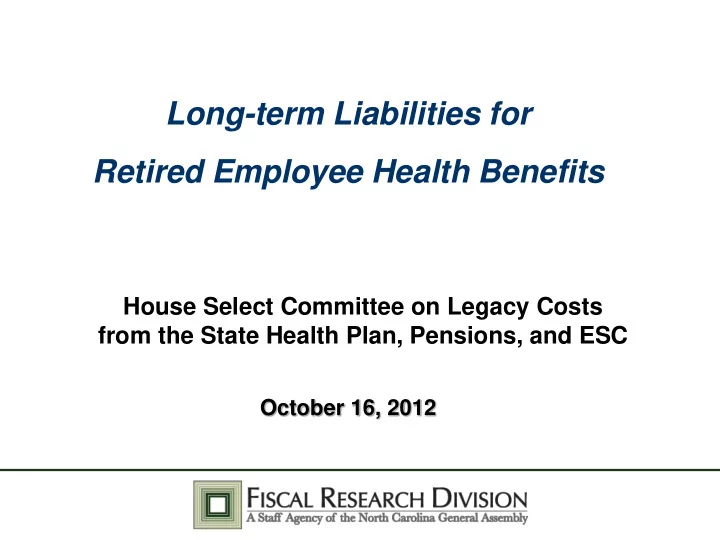

Long-term Liabilities for Retired Employee Health Benefits House Select Committee on Legacy Costs from the State Health Plan, Pensions, and ESC October 16, 2012
Outline of Presentation 1) Benefits Overview 2) Financial Status 3) Funding Projections 4) Comparison to Other Employers 2
Benefits Overview – Most retired State employees pay premiums of $0 to $23 per month to participate in the State Health Plan * – Retiree’s portion of the premium represents at most 5% of the total premium paid by the State and the retiree – Retiree pays the full stated premium for dependent coverage if retiree elects to cover dependents * Those hired on or after October 1, 2006 will pay a much larger premium if they retire with less than 20 years of service, but they constitute a small fraction of current retirees. 3
Benefits Overview – When the retiree becomes eligible for Medicare, the State Health Plan coverage becomes secondary and the retiree is expected to enroll in Medicare Parts A and B, but not D – Services covered and network of providers are comparable to those in plans typically provided to active employees by large public and private employers – Out-of-pocket requirements are somewhat higher than average among large employers 4
Financial Status Measure Value at Dec 31, 2011 Accrued Liability for Active Employees (pro-rated $16,709 Million share of total value of future benefits) Accrued Liability for Retired and Terminated $13,630 Million Employees Total Accrued Liability $30,339 Million Assets - $729 Million Unfunded Liability $29,610 Million 5
Financial Status Unfunded Accrued Liability $50,000 $45,000 $40,000 $35,000 $ Millions $30,000 $25,000 $20,000 $15,000 $10,000 $5,000 $0 2010 2012 2014 2016 2018 2020 2022 Fiscal Year Ending Assumes current contribution practice and benefits package. 6
Funding Projections Current contribution practice: – Current contribution for retiree medical benefits is set in the Appropriations Act – Usually enough to pay claims and administrative expenses for current retirees plus a small cushion 7
Funding Projections $4,500 $4,000 $3,500 $3,000 $ Millions $2,500 $2,000 $1,500 $1,000 $500 $0 2010 2012 2014 2016 2018 2020 2022 Fiscal Year Ending Current Practice Normal Cost 8
Funding Projections Annual Required Contribution: – Amount calculated by actuary under government accounting standards (GASB 43/45) – Sum of: – Normal Cost: amount to pay for benefits accrued in current year by active employees – Amortization of Unfunded Liability: amount to pay off unfunded liability over 30 years 9
Funding Projections $4,000 $3,500 $3,000 $ Millions $2,500 $2,000 $1,500 $1,000 $500 $0 2010 2012 2014 2016 2018 2020 2022 Fiscal Year Ending Normal Cost UAL Amortization Annual Required Contribution Annual Required Contribution assumes current contribution practice and benefits package. 10
Comparison to Other Employers Other States – All 50 states offer retiree medical benefits to at least some employees – Differences are mostly in: – Who is eligible – How coverage changes upon Medicare eligibility – Share of premium paid by retiree – N.C.’s per capita unfunded liability is 9 th highest in the U.S. – About 70% of states require more than a nominal premium from the retiree – Few states have set aside significant assets to pay future benefits 11
Comparison to Other Employers Neighboring States - Examples – South Carolina: – Retirees hired before 2008 are eligible for full employer subsidy with 10 years of service. – Employee- only premium is $10 per month in S.C.’s Savings Plan and $98 per month in S.C.’s Standard Plan. – Per capita unfunded accrued liability is only slightly smaller than N.C.’s. – Virginia: – State provides premium subsidy of $4 per month per year of service, retiree pays the remainder of the premium. – Per capita unfunded accrued liability is less than 10% of N.C.’s. 12
Comparison to Other Employers Private Sector – In 2012, 25% of large firms and 4% of small firms that offered medical benefits to employees also offered them to retirees – In 1988, 66% of large firms offered retiree medical benefits – Of those that do offer retiree medical, over 40% require retiree to pay the full premium. Another 30% have capped employer contribution at a fixed dollar amount. – Number of employers offering retiree medical may decline further in 2014 if everyone is guaranteed access to coverage through exchanges, although some might still provide credits to purchase insurance – Few companies have set aside significant assets to pay future benefits 13
Fiscal Research Division Contact David Vanderweide Fiscal Research Division Suites 203 and 619 Legislative Office Building 919-733-4910 david.vanderweide@ncleg.net www.ncleg.net/fiscalresearch 14
Recommend
More recommend